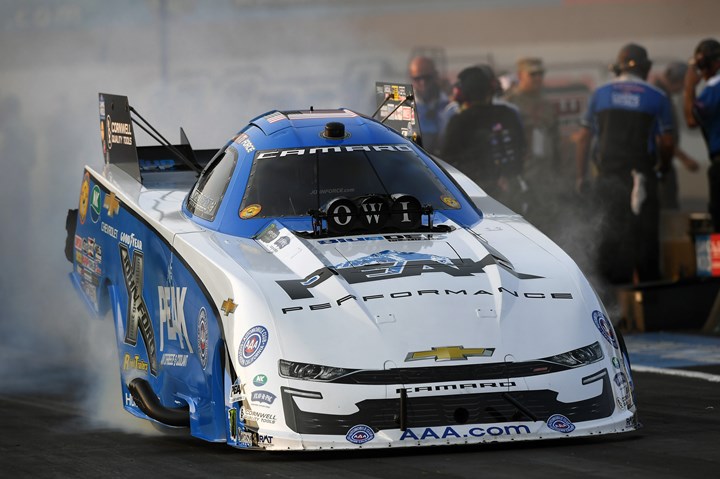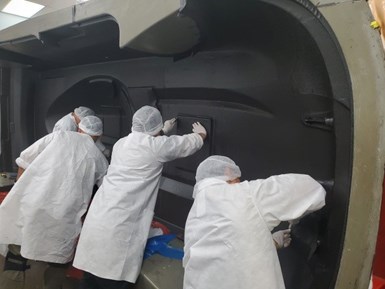
One-piece, 18-foot-long composite vehicle bodies. Funny Car drag racing vehicles compete at speeds of more than 300 miles per hour over a short, 1,000-foot distance, meaning aerodynamic design and extremely low weight are crucial to achieving award-winning vehicle performance. For more than 25 years, the team at MTCcorp has worked closely with customers like John Force Racing to design and manufacture generations of 18-foot-long, single-piece carbon fiber composite vehicle bodies. Photo Credit: Gary Nastase for Auto Imagery, via John Force Racing
Organized drag racing began in the 1930s and 1940s, growing over time into today’s highly competitive industry, featuring more than 20 official vehicle classes that race at speeds of more than 300 miles per hour. Funny Cars are a class of drag racing vehicle described by the National Hot Rod Association (NHRA) as having “a carbon fiber body that loosely resembles a production-based automobile.” Evolving over more than 50 years of competitive racing, today these vehicles reach speeds of more than 330 miles per hour on relatively short, 1,000-foot drag strips. To reach these speeds and qualify for official competitions, Funny Cars have to be passenger-safe, ultra-lightweight, aerodynamic and fit the NHRA’s stringent dimension requirements.
While all automotive and motorsports vehicle bodies are complex to design and manufacture, Funny Cars may be even more challenging than most, featuring a tilt-up, one-piece composite body that can be more than 17 feet long. Metalcrafters Transparencies and Composites Inc. (MTCcorp, Fountain Valley, Calif., U.S.) is one company that has helped to pioneer the modern composite Funny Car body, starting in the mid-1990s with core customer John Force Racing (JFR).

Preparing the master mold. A foam master mold for each vehicle body is CNC machined by MTCcorp from 3D models developed per the customer’s specifications (shown here). A layup mold is then created from this master mold. Photo Credit: MTCcorp
MTCorp was founded in 2017, spun off from a California-based automotive prototyping firm. The fast pace and precision required of prototyping led to an expansion into aerospace, space and defense industries as well. Today, MTCcorp says its core competencies are five-axis CNC machining, traditional and advanced composite lamination, and formed or tempered glass transparencies, able to handle production volumes ranging from tens to thousands of parts annually.
The company’s history and competencies have served it well in the area of Funny Cars, allowing for custom innovations as well as steady production over multiple distinct generations of vehicles for John Force Racing.

Laminating the car body. Technicians carefully lay up hundreds of individual prepreg plies within the mold. Photo Credit: MTCcorp
John Force, 16-time NHRA Funny Car world champion and CEO of John Force Racing, states, “We’ve been working with MTCcorp for years now. They make a nice product — the best. We put these bodies through 11,000 horsepower at 330 miles per hour. We can’t afford to not have the best. They’re easy to work with and always deliver on what we need.”
Designing one-piece, all-composite Funny Car bodies
Gary Grossman, primary composites engineer at MTCcorp, has been working on the Funny Car program since it started. He explains that alongside passenger safety and aerodynamics, light weight is the key factor for any Funny Car design, given the high speeds and short distance of races. One way to achieve the lowest possible weight is to design each body as a one-piece shell with minimal components. Following the current body generation and NHRA specifications, each of the bodies MTCcorp manufactures weighs approximately 100 pounds and measures 18 feet long, 4.5 feet tall and 7 feet wide.

Preparation for autoclave cure. The laid up part is vacuum bagged and prepared for autoclave cure.
Photo Credit: MTCcorp
Since the beginning, MTCcorp has also evolved — and pioneered — its method for manufacturing the bodies. “When we started, virtually all the bodies of this type were old-school wet layup fiberglass with some carbon involved,” Grossman explains. From the start of MTCcorp’s partnership with John Force Racing, the goals were higher performance, lower weight and better consistency than what was currently standard on the market. “We took the old approach and completely revamped it,” Grossman says.
In the mid-1990s, Grossman and the team that is now MTCcorp designed and CNC machined a foam master plug, laminated composite molds from it and began manufacturing the car bodies using autoclave-cured prepregs and honeycomb core — new for the application at that time. The company also installed a large 10- x 20-foot autoclave in order to cure the entire car body at one time in a multipiece tool. MTCcorp also has several large Zimmermann (Neuhausen, Germany) five-axis CNC machines to support machining of the full-size master plug in one setup. Additionally, the company performed engineering and analysis to match the new manufacturing process with the new prepreg materials it was using. Materials use evolved over time from mostly fiberglass to today’s carbon fiber composite construction.

Autoclave cure. The entire mold is lifted into MTCcorp’s 10- x 20-foot autoclave for curing. Photo Credit: MTCcorp
“We introduced an aerospace-type solution into automotive motorsports,” Salvatore Caravella, president of MTCcorp, notes. “It was revolutionary at the time for Funny Cars. Implementing new processes involves both seeking out expertise as well as pushing the envelope and trying new things that haven’t been done before. There are successes and there are failures, but with every failure, there’s a lesson. Knowing what not to do is equally important as knowing what to do. In the early history of the company, necessity drove innovation and skill building.”
Today, each vehicle body generation starts with a digital model, fed by results from aerodynamic studies, dimensional requirements and other key factors. The resulting bodies are made from hundreds of individual ply pieces of various sizes and shapes, cut from carbon fiber prepreg on a CNC ply cutting table and laid up by MTCcorp’s skilled technicians.
“Some of these pieces are extremely small, or irregularly shaped, but each has a specific purpose, and that’s one way we can minimize the weight on the final product,” Grossman explains. “We also pay very strict attention to other things that can add weight, like the adhesives we use or the amount of honeycomb core used — we control it all very carefully because even an extra pound of something in one of these bodies is a big deal.” MTCcorp typically provides John Force Racing multiple identical vehicle bodies each season.

Finishing. After molding, the finished part is trimmed and delivered to the customer for assembly. Photo Credit: MTCcorp
The company continues to produce Funny Car bodies for its customers, more than 25 years into the start of the program. Meanwhile, the skills and techniques learned from this industry have translated into other areas of MTCcorp’s business. “This task of producing large, highly engineered composite components has validated MTCcorp’s capabilities to be able to support aerospace and defense customers as well,” Caravella says. “We have built some exciting projects such as the X-56 for Lockheed Martin, [which is] a blended wing flying body designed to study flutter suppression; patented an airborne CFRP [carbon fiber-reinforced polymer] electronic equipment rack with Northrup Grumman; and manufactured glass windshields and composite windshield frames for a variety of aircraft including the Boeing 787, Lear Jet 45 and others.”

Final product. The final assembled vehicle is ready to hit the drag strip. Photo Credit: Gary Nastase for Auto Imagery, via John Force Racing
Robert Hight, a three-time NHRA Funny Car world champion and president of John Force Racing, adds, “When it comes to the type of precision and attention to detail we need for one of our Funny Car bodies, we need the best. The MTCcorp team is efficient and reliable, and their product never disappoints. John Force Racing has had a great experience working with MTCcorp over the years and we know it will continue into the future.”
Related Content
SMC composites progress BinC solar electric vehicles
In an interview with one of Aptera’s co-founders, CW sheds light on the inspiration behind the crowd-funded solar electric vehicle, its body in carbon (BinC) and how composite materials are playing a role in its design.
Read MoreAutomotive chassis components lighten up with composites
Composite and hybrid components reduce mass, increase functionality on electric and conventional passenger vehicles.
Read MoreRecycling hydrogen tanks to produce automotive structural components
Voith Composites and partners develop recycling solutions for hydrogen storage tanks and manufacturing methods to produce automotive parts from the recycled materials.
Read MoreThermoplastic composites: Cracking the horizontal body panel nut
Versatile sandwich panel technology solves decades-long exterior automotive challenge.
Read MoreRead Next
Mercedes-AMG GT4 race cars now equipped with Bcomp natural fiber composite bumpers
Bcomp works with engineering specialist HWA to phase in natural fiber bumpers, replacing carbon fiber versions. Analyses report a 90% reduction in material emissions and thermal energy recovery potential.
Read MoreThe evolution of composites in NASCAR
The growing role of carbon fiber in stock car racing.
Read MoreDeveloping bonded composite repair for ships, offshore units
Bureau Veritas and industry partners issue guidelines and pave the way for certification via StrengthBond Offshore project.
Read More

.jpg;width=70;height=70;mode=crop)





















